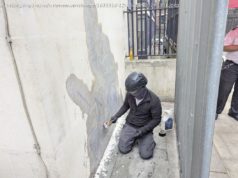Elza Paula Pinkham first learned bead work as a child, but she admits she didn’t pay close attention as her mother tried to teach her the traditional native craft.
Elza Paula Pinkham first learned bead work as a child, but she admits she didn’t pay close attention as her mother tried to teach her the traditional native craft.
« Seventeen years ago I went to the store and got a book. I’ve been doing it every day since, » Pinkham said as she finished a pair of child-size moccasins during a recent bead work and corn husk weaving demonstration at the Yakima Valley Museum in Yakima.
As they watched, several visitors asked Pinkham if she teaches. While she would like to lead a class, materials are expensive and finding a public space can be challenging.
But now a new statewide program aims to help. The Center for Washington Cultural Traditions is working to ensure that skills such as Pinkham’s don’t disappear. By offering apprenticeships and other programs, it hopes to preserve and document traditional crafts — many of which have been handed down over the centuries — and support those who carry them out as well as advance public understanding.
« This was born out of about three years of planning, » said center director Kristin Sullivan, who has crisscrossed the state getting ideas for the center.
It’s important to preserve and celebrate cultural traditions that make communities unique, Sullivan said.
« We are all folk of some community, » she said. « Almost every state has folk and cultural arts programs. »
For example, the California Cultural and Historical Endowment preserves and protects that state’s cultural resources, including artifacts, collections, archives, historic structures and properties.
« Their mandate was to help preserve historic buildings or historic collections that were in peril, » said David Burton, interim executive director of the Yakima Valley Museum.
Burton is the former senior director of the Institute for the Study of the American West at the Autry Museum of the American West in Los Angeles, which received nearly $1 million from the state program while he was there.
Museums help keep local traditions alive, as do churches and organizations and groups, such as the Yakima Hispanic Chamber of Commerce, the Sons of Norway, the American Historical Society of Germans From Russia and descendants of Japanese, Chinese and Dutch pioneers.
« There’s strong interest in learning about the traditions of new immigrants, especially Latinos, » Sullivan noted. « There’s a lot of interest in connecting tradition bearers and schools. »
In the short term, the center wants to create an apprenticeship program and develop local partnerships. In the long term, organizers plan a website with a roster of tradition bearers and permanent statewide partnerships. The website will serve as a clearinghouse of the state’s cultural traditions, Sullivan said.
An actual brick and mortar building isn’t planned.
The recent event at the Yakima Valley Museum featured several Yakama tribal artists who have practiced their crafts for decades. However, Pinkham’s son, Sky Louis Weaselhead, 25, first started making corn husk baskets about eight years ago.
« He’s one of the youngest corn husk weavers I know, » said Miles R. Miller, an independent curator who organized the event.
Before the reservation era, Miller said, corn husk bags were about 2 feet long and 1½ feet wide and were used to store roots. Most use today’s smaller corn husk bags as a regular purse, he said.
« They’re used as an everyday bag — a very prized everyday bag, » said Miller, who has been beading for about 30 years, learning at age 18.
Doris Shippentower, 59, learned to thread a needle in the late 1960s, with her work getting increasingly intricate over the years. She and husband George Strong Sr. sat behind two long tables at the event covered with their artistry, including entire outfits and other clothing, accessories and bags.
« When I learned to bead work, I’d make things like this to give to friends, » she said, gesturing toward some of the bags and accessories. A larger beaded bag showing several kinds of birds appearing almost three-dimensional in its rich color and exacting detail.
Events such as the Aug. 17 demonstration are important because they give the greater public a better idea of the value of Native crafts and traditions. Miller enjoyed interacting with guests while creating art at the same time.
« I really enjoy doing bead work. It’s almost meditative. It takes me away from stuff that’s going on, » he said.
Sign up today for a free 30 day free trial of unlimited digital access.






